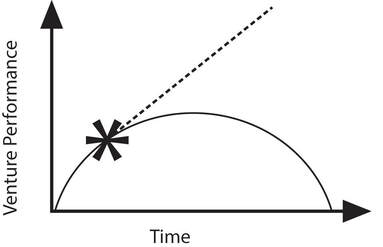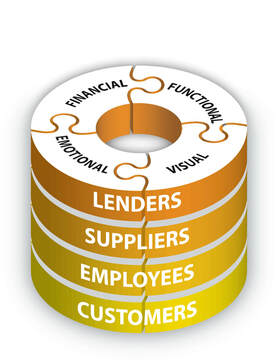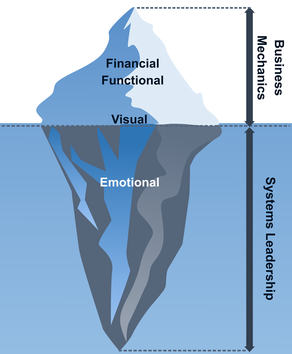Chapter 5
We’re blind to our blindness. We have very little idea of how little we know. We’re not designed to know how little we know
Daniel Kahneman
Snow blindness is a painful, temporary loss of vision due to overexposure to something unseen—the sun’s UV rays reflecting off the snow.
Business blindness is a temporary loss of leadership vision due to overexposure to something unseen—human dynamics reflecting off deep drifts of resistance, worry, and concern. Business blindness is painful financially, functionally, spiritually, and emotionally.
Loss of momentum happens in organizations all the time. A task or project carries a certain intensity and is travelling at a certain speed at conception. Then it’s handed off to someone else and the energy diminishes. Momentum is lost as the assignment bounces off other people’s questions, concerns, apathy, or lack of support. Bright ideas fade to black.
If the outcome is important enough to us, we try to resurrect the momentum. That’s when we get caught up doing things we think others can’t handle. We jump in to fix or rescue, blaming “them.” We are the hero, the wise one who knows how important the assignment or duty is.
Truth time: The issue is a symptom of systemic failure. And it’s a big deal.
Business owners and CEOs are easily seduced by crisis. Being called to action gives us a hit of adrenalin. The ego likes to think of itself as an indispensable problem-solver. But when we jump in to save the day, our attention is pulled from the strategic priorities that add significant value to the organization over the long term. Instead, we stand knee-deep in the operational details. We allow precious time that was intended for preventive and forward-thinking activities to be consumed by busywork and distractions that require immediate attention.
Daily activities turn into habits and predictable patterns over time. Soon we are rooted in a whirlwind of activities that has nothing to do with our strategic priorities or the destination we set our sights on.
Long-term strategic work gets squeezed out by pressing problems and urgent priorities. Crisis mode steers us off course.
If the words “I don’t have time …” are frequently in your vocabulary, you have business blindness. I don’t have time to sketch an organizational chart (showing functional accountabilities so people know where to go when problems arise). I don’t have time to document step-by-step operational procedures (so new hires can learn the job more quickly). I don’t have time to clarify performance expectations (by creating position contracts for each staff member). Sound familiar?
If you consistently find yourself operating in crisis mode, you have business blindness.
If your people need to be micromanaged and you have to save the day, you have business blindness.
Don’t worry. I have the cure: team and systems leadership.
Some leaders grow their businesses exponentially. They shift the paradigm of existing markets, like Steve Jobs did with Apple or my Uncle Bill did with whiskey sales. Sadly, most small businesses stay small and struggling.
A line of demarcation separates businesses that grow rapidly from those that stay small. It relates directly to business owners remaining hands-on at the pivotal moment when they need to shift their approach from doing to leading. Can you imagine the positive economic impact that would result if more businesses crossed this dividing line?
If you’re delegating tasks and assignments to subordinates and getting passive-aggressive resistance, employee turnover, and attitude push-back in return, look no further than yourself. I’m sorry to say it, but somebody has to tell you the truth.
You’re reading this book because you’ve reached a fork in the road. If you stick with the familiar, what the mainstream world tells you about delegation and success, you will move through the predictable stages of the business life cycle. It may be good for a while, but statistically, you’re likely to follow the dark line on the curve in the image below.

Before we can manage other people, we must manage our way of being, our words, our fears, our automatic reactions, and our emotional triggers. No miracle pill, quick fix, or magic wand will make it all better.
Most growth stems from pain, unfortunately. Even the shell of a seed splits open to allow the new shoot to grow. Entrepreneurs are motivated to solve problems that irritate them. How you channel that energy makes all the difference in the world.
If we avoid and internalize our pain and frustration, they become our ego. It therefore appears that the world is going to hell in a handbasket. However, if we externalize the pain by creating an inspiring new future—a dream that is bigger than we can possibly accomplish on our own—that same passion becomes our power to create.
Read that paragraph again before proceeding. Stand up and stretch, pour yourself a cup of tea, go for a short walk. Let that truth soak in. Don’t pass it off by saying, “I already know that.” You want to feel your potential in your bones.
It’s mission critical to be able to step outside your day-to-day activities to look at the bigger picture. Only by looking at your business from the outside (inside out, upside down, and backwards) can you see what’s really going on.
When I assess a business, I look for gaps and inconsistencies with beginner’s mind. You can do the same. Beginner’s mind has two aspects:
No matter how good you think you are as a leader, my goodness, the people around you will have all kinds of ideas for how you can get better. So for me, the most fundamental thing about leadership is to have the humility to continue to get feedback and to try to get better—because your job is to try to help everybody else get better
Jim Yong Kim
Startups dream of becoming the next Google. Employees want to work at Google or a company just like it.
“Nearly everybody from my mother to my cab driver pretty much demands you explain why you’d be anything less than thrilled to work at Google,” said one former employee.
Google is synonymous with a cool workplace. Those of us on the outside envy the staff perks of free food, in-office massage, gyms, daycare, and other practical and fun facilities. People who’ve worked at Google say none of that matters.
Insiders talk about their experience in terms of meaning: “You’ll work on problems that affect tens of millions to billions of people every day.”
They talk about teamwork and a sense of belonging: “You’ll get to work with some of the smartest people in the world.”
They talk about being intellectually challenged: “You’ll be asked to work on some of the hardest technical problems currently being solved.”
Can you hear the personal significance in these statements? The emotion?
Mention the word “emotion” to most business owners and they roll their eyes, anticipating a tearful talk about “feelings.” When it comes to operational and financial decision-making, they see emotion as an irrational influence that distorts reasoning. They sideline emotion and try to cut it out of internal processes.
What a mistake.
Emotions run deeper than recognizable feelings like happy, sad, or angry. Establishing an emotional connection with another person builds trust, unlocks latent talent, and inspires others to stretch beyond their comfort zones. Emotion is the magic potion that fuels inspiration, creativity, and innovation in the workplace. Performance revs into high gear when technical function fuses with emotion.
As I touched on in Countdown to Liftoff, systems have sixteen dimensions. Each is an important aspect of systematic business growth. There are four design preferences, visual, emotional, functional, and financial, first outlined by Michael Gerber in his book The Power Point. Business success largely depends on attending to all four preferences— including emotional ones. Lack of congruence leads to business failures.
The four design preferences must satisfy four primary influencers: customers, employees, suppliers, and lenders. Effective systems engage
all of them in meaningful ways.

If your business is a rocket, these are the building blocks of your fuselage.
I can already hear your objections: “Are you nuts?” (No.) “Seriously, you expect me to build systems that appeal to all these different perspectives?” (Yes.) “You don’t understand what it’s like, here on the ground in my business.” (Oh, but I do.)
Companies with strong branding and great aesthetics tend to nail the visual preferences. Clients are seduced with a great look or terrific packaging. But then the company allows another part of the system to falter, perhaps with a cumbersome return policy (emotional, functional). Mixed messages counteract the positive first impression. One or more elements have been missed and there is a disconnect, an incongruence.
Incongruence = unintended consequence of a systemic disconnect.
Highly creative (visual) entrepreneurs often place too little emphasis on the business’s operational requirements (functional) or revenue-generating activities (financial). An example would be graphic designers or photographers who do all the work themselves. The product may be great, but profit is poor, and the owners claim no one else can do the work they do. Incongruence leaves the owner to do all the work and leads to poor sales and an unhealthy balance sheet. In this example, the owners have created a job, not a business.
Inventors and people with strong mechanical minds can spend an inordinate amount of time organizing and building a better mouse trap (functional) at the expense of the bottom line practicality (financial).
If you have any experience with government contracting, you may know a thing or two about incongruence. Think of the nine-hundred-page contract specifications requiring an otherwise standardized product to be ridiculously over-built. I’ve had reports of publicly tendered projects costing taxpayers two to four times as much (sometimes even more) as it would have cost to build the same product in the private sector. In fact, I once received a bid from a public agency to construct a boat ramp on the Fraser River for $250,000. We hired a private engineering firm to oversee the project and completed
construction for a quarter of that price. Sadly, I have heard far too many accounts like this one.
Overemphasis on the business’s financial preferences fuels corporate greed. Profit and shareholder return are critical, but not at the expense of the physical, mental, and emotional well-being of people and environmental stewardship. Occupy Wall Street was organized in protest of this type of systemic imbalance.
A sterile, bureaucratic environment creates staff who are uninspired and disengaged. That’s the result when functional preferences are overemphasized. Volumes of policies and procedures do not allow sufficient room for the judgement, autonomy, and decision-making associated with engaged workers (emotional). Government and not-for-profit organizations whose culture encourages the frivolous practice of spending the remainder of the budget at year-end are not looking at the bigger picture or the long-term (financial) consequences on taxpayers.
These examples all relate to the Possibility Zone steering wheel we talked about earlier. Too little structure, not enough communication, or lost focus on the original intention steers things into the yellow and red zones on the left. Too much structure, domineering opinions, or focus on the outcome at the expense of primary influencers steers the wheel too far to the right.
If you recognize your enterprise in any of these examples, don’t take it personally. People are naturally dominant, or competent, in one or two preference areas. As a result, the others get neglected.
As I discussed in Part I, judgement is subjective and subconscious. Most people’s decision-making is affected by Invisible Barriers, the intangible factors that undermine individual and organizational success. Navigating human dynamics, within ourselves and when working in groups, requires daily awareness of the barriers that impact reactions and relationships. Building emotional “experiences” into your systems gives the leverage needed to move the customer satisfaction needle from meeting minimal standards to having customers rave about you and refer you to others.
Business tangibles such as marketing, operations, and finance are the tip of the iceberg. We focus on the tip in our desire to make our lives concrete, describable, and understandable. We tell ourselves it’s safe and predictable, but really, not only does the bulk of the iceberg lurk beneath the surface, its below-surface mass determines the direction and movement above. Just like an iceberg, the superstructure of a business rests on a foundation of emotions and patterns, unknown and unseen.

We focus on the tangible elements of business—product sales, marketing strategies, policies and procedures, financial analysis—and wonder why the results we’re looking for elude us. Tangibles must function well, of course, but they don’t drive the business. People drive the business, and people are complex emotional beings, whether we like to admit it or not.
People tend to lean toward their strengths, so businesses get designed for workflow, function, and finance—not feelings.
Sales and marketing campaigns are designed to engage our customers’ emotions and influence them to buy our products and services. Yet the emotional preferences of the other primary influencers—our employees, suppliers, and lenders—are routinely overlooked. Can you see how quickly systemic disconnect— incongruence—throws us off course?
Dale Carnegie said it decades ago: Eighty-five percent of success comes from soft skills, and only fifteen percent comes from technical skills. What if we did a better job of designing businesses with this principle in mind? We’d steer straight toward the ideal future, neither over-functioning to the right or under-functioning to the left. Our businesses would operate in the Possibility Zone.
Business owners can unintentionally trigger a chain reaction of emotion that flows through all the primary influencers of the business. A disgruntled or ineffective employee can sour a customer’s experience, undoing years of goodwill in a heartbeat.
Understanding workplace emotion makes it possible to design experiences that delight customers and leave employees feeling valued. How much easier would your life be if front-line employees were motivated to identify cost-cutting measures or inspired to add value to products, programs, and services?
We tend to collapse people and business, blending them together with no separation or definition. We can’t tell where business management ends and systems leadership begins. To achieve high performance and functional effectiveness, we must separate people and function. Instead of concentrating solely on business mechanics, we must also delve into the depths of systems leadership, culture, and CCL (communication, collaboration, and leadership).
Business function is one component of success; human performance is another. The two must interact harmoniously because each affects the other. What’s more, harmony must be factored into systems design; it won’t happen automatically. I call it emotional resonance. When emotional resonance is missing, friction builds. Friction causes serious damage, like operating a vehicle with no oil in the engine. Invisible performance barriers—attitude, behaviour, resistance, withholding information, defensiveness, recurring problems—then impede business function.
Emotional resonance is achieved when all your systems are in alignment. People are working independently (from their strengths and passions) and collectively (through functional departments) toward a common shared vision. There is nothing more powerful than an organization that has effectively aligned the individual needs and wants of its employees to the company’s vision and mission. What you focus on expands.
Establishing emotional resonance in the workplace is not about sitting around talking to people about their “feelings.” Conversations like that are unlikely to surface the information you need to bring about systemic change, particularly when language is used to protect, defend, and justify behaviours, keeping the old paradigm in place.
Nonverbal cues highlight incongruence more accurately than spoken words because much of human behaviour is subconscious—but it reveals itself through behaviour patterns and business cycles. Pay less attention to what people say and more attention to what they do: their nonverbal clues, the informal flow of information (more on that in the next chapter). Truth reveals itself through actions. “Off” behaviour is observable. Once you start looking for it, it will be like seeing the steel barge in the middle of the street.
If you think you are equally strong in all four systems preferences (visual, emotional, functional, and financial), yet you are not living your dream, consider that you are operating on one, two, or even three flat tires. It’s time to pump them up! I’m going to show you how.
Remember: Your goal is to establish congruence across all sixteen dimensions of systems design. Wherever your actions (or results) are inconsistent with your intentions, the disconnect produces an unintended consequence. Create your systems with intention. Consider emotion a design element. Otherwise, a reactionary culture or environment of complacency or resistance will form by default.
© Discovery Centre for Entrepreneurship Inc. 2006 – 2024. All rights reserved.
We use essential cookies to make our site work and to improve user experience and analyze website traffic. By clicking “Accept,” and/or continuing to use our website you agree to our website’s cookie use as described in our Privacy Policy.